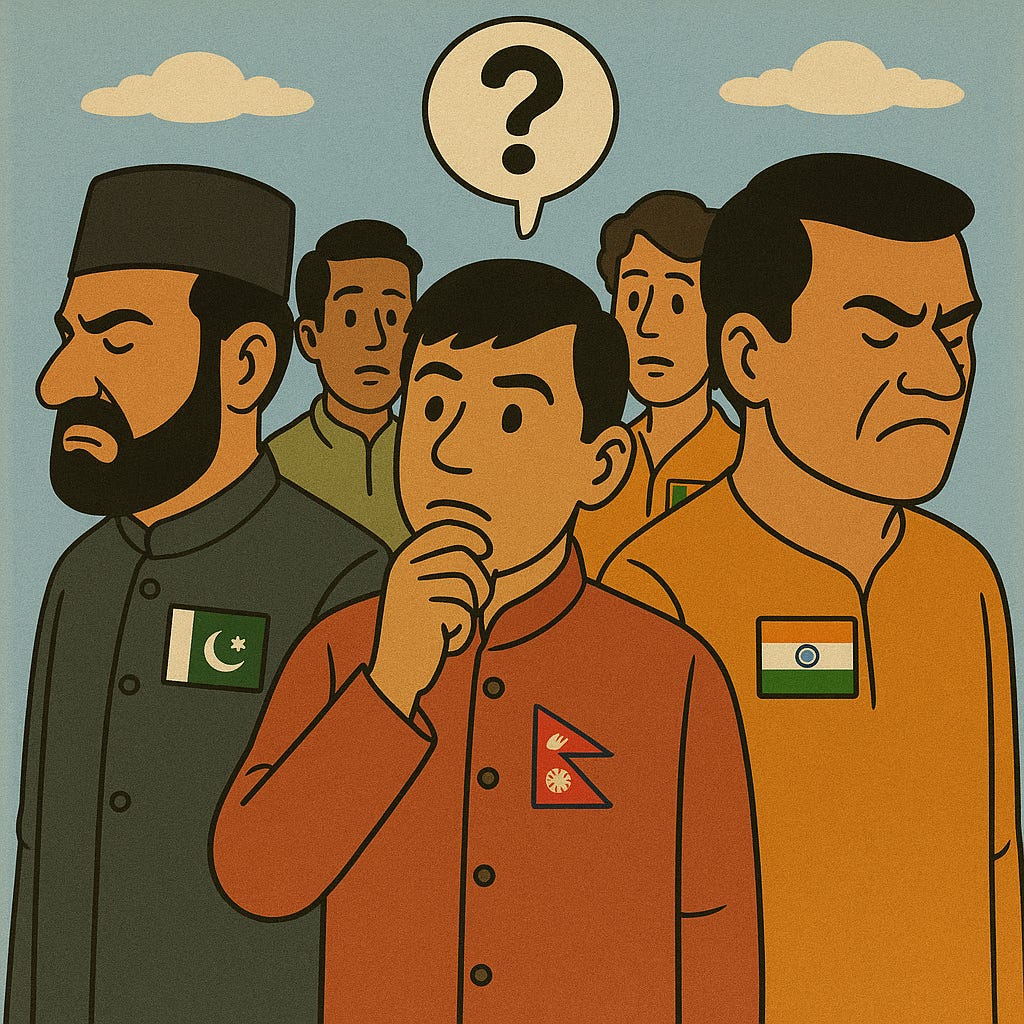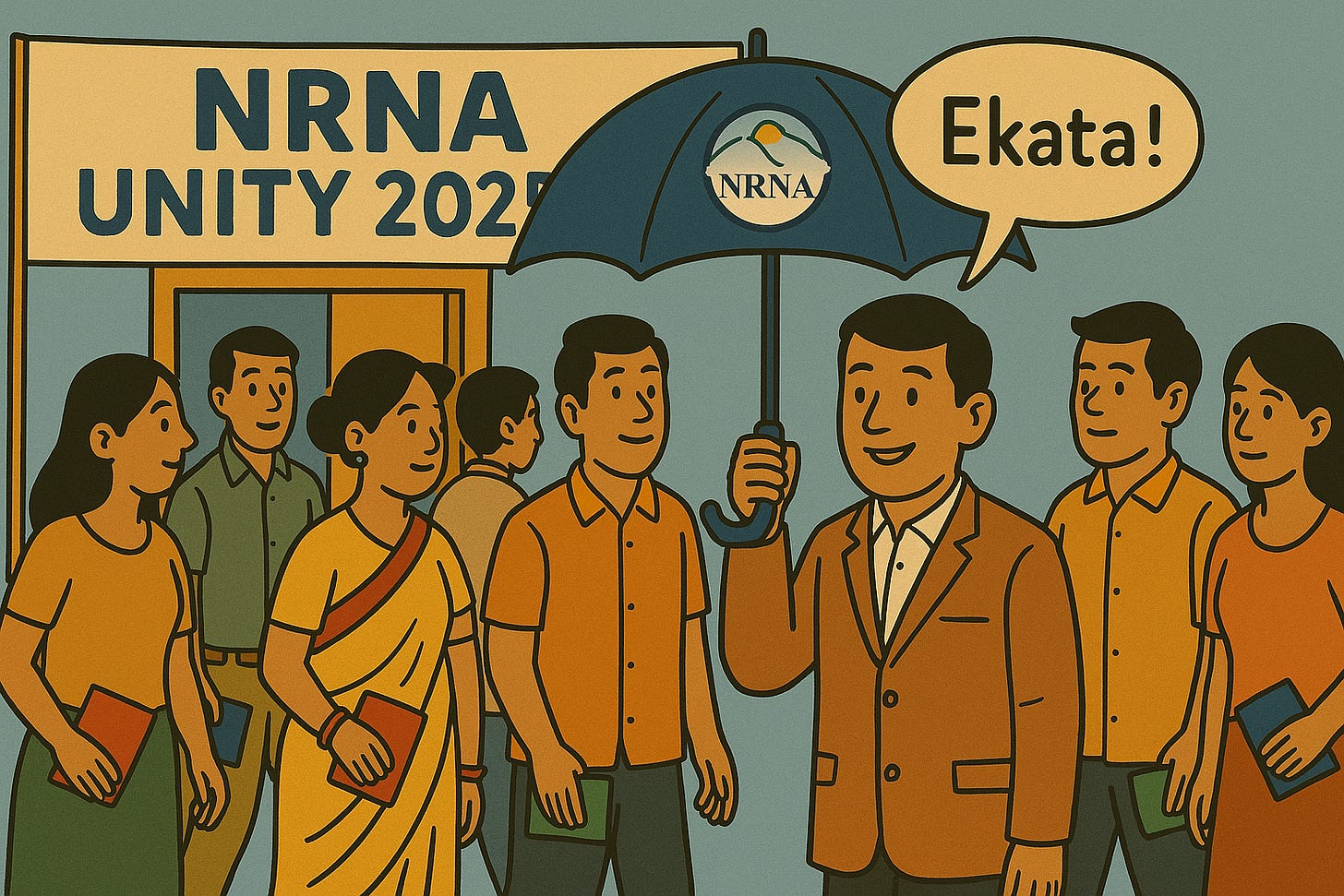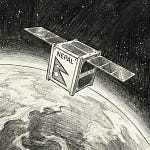Making these ain’t easy. Share the love! Help others that care about Nepal stay up to date the easy way. If you like this issue, share it with a friend who follows Nepal and hit Subscribe for your weekly dose of curated, can’t-miss updates.
Another week, another balancing act: Nepal’s leaders are juggling regional firefights, billion‑rupee megaprojects, a globe‑trotting diaspora that just wants one NRNA, Sherpa world‑records in the clouds, and mosquitoes on the march. Buckle up—this issue sprints from border bunkers to Everest’s summit in under five minutes.
Politics & Governance 🪧
India’s launch of “Operation Sindoor”—air‑, drone‑ and artillery strikes on alleged militant sites in Pakistan—has unleashed retaliatory salvos dubbed “Operation Bunyān al‑Marsūs,” nightly cross‑border shelling and flight curbs at 29 Indian airports. Kathmandu switched to crisis gear immediately: the Foreign Ministry says it is in 24/7 contact with roughly 100 Nepali students in Pakistan and has opened hotlines for citizens in both countries, condemning terrorism while pleading for restraint (KTM Post). Meeting Indian Ambassador Naveen Srivastava, Prime Minister KP Sharma Oli reaffirmed that Nepali soil will never be used for hostile acts and welcomed India’s pledge to keep vital fuel and trade routes flowing south despite tighter security checks (KTM Post).
Parliament is pressing the executive to back words with action. Speaker Devraj Ghimire issued a formal ruling instructing ministries to draft evacuation plans after Nepali students in Lahore reported airspace shutdowns and citywide blasts; RSP lawmaker Sumana Shrestha even brandished an email pleading for a charter flight home (Republica). On the ground, the Armed Police Force has stepped up ID checks at Nepalgunj and other open crossings, mirroring India’s clampdown, while the Chinese Embassy has advised its nationals to avoid the porous Nepal–India frontier—highlighting how jittery the neighbourhood has become (TRN).
At home, rhetoric is split but urgency is shared. The ruling Nepali Congress called India’s strikes “a justified stand against terrorism” (THT), but opposition parties and civil‑society voices are urging Kathmandu to remain “neutral yet not passive,” warning that overt alignment could expose Nepal to economic shocks and diplomatic backlash (Republica). With more than 30,000 Nepalis serving in India’s armed forces, a rupee peg vulnerable to regional turbulence and supply lines threading straight through the conflict zone, policymakers are scrambling to balance principled neutrality with hard‑nosed contingency planning for citizen safety, trade continuity and currency stability.
Economy & Development 💸
The week’s headline deal is pure megawatt: government planners are sculpting a financing package—spanning Nepal, India, Bhutan, Bangladesh and Sri Lanka—for the 10,800 MW Karnali–Chisapani multipurpose project (Republica). To keep the broader pipeline realistic, the National Planning Commission has slashed its Project Bank to 7,337 vetted entries from 18,000, while Investment Board Nepal’s new four‑year strategy targets at least 25 PPP megaprojects worth up to USD 14 billion (Republica). Complementing the hard‑hat push, a freshly issued Foreign Aid Mobilization Policy 2025 promises faster approvals and stricter monitoring so record donor pledges translate into shovels on the ground—timely prep as Nepal eyes graduation from LDC status in 2026 (Republica).
Clean‑tech ambitions are sprouting outside the capital too. Koshi Province inked a Rs 26 billion green‑hydrogen fertiliser plant—Nepal’s first—during its investment summit, headlining 46 projects worth Rs 52 billion (Republica). Farther west, the 25 MW Seti River hydropower plant has come online after a Rs 6 billion build, and Bhairahawa’s Special Economic Zone notched Rs 770 million in exports during nine months—both signs that energy and manufacturing are finally picking up speed (TRN).
At the grassroots, the government green‑lit 661 start‑ups for subsidised loans of Rs 2.5 million at 3 percent interest, betting that nimble entrepreneurs can turbo‑charge rural economies (Republica). Urban services are expanding too: the Melamchi water network will stretch an extra 875 km beyond Kathmandu’s Ring Road, reaching 63,000 new taps (Republica). And in a nod to nostalgia—and sunk assets—the Cabinet has revived plans to resuscitate seven long‑defunct state‑owned factories via fresh PPP deals, though analysts warn real success will hinge on political follow‑through and private‑sector appetite (KTM Post).
Diaspora & Globalization 🌏
After years of factional bickering, the Non‑Resident Nepali Association finally held a Supreme‑Court‑mandated unity convention and unanimously elected Japan‑based entrepreneur Mahesh Shrestha as president. Foreign Minister Arzu Rana Deuba told delegates her ministry recognises this NRNA—and only this one—urging members to park party loyalties “under a single umbrella” so diaspora capital and know‑how can reach Nepal unimpeded (KTM Post). The closing Kathmandu Declaration called for fast‑tracking voting rights and investment reforms, signalling a reset after months of paralysis (Republica).
Debate now shifts to dual‑citizenship. Speakers from 84 countries argued that the lack of secure legal status deters big‑ticket investment and leaves migrants exposed if host nations revoke papers (ICT Frame). Deuba echoed that concern once—warning politicisation could derail progress—while former PM Baburam Bhattarai urged lawmakers to align policy with constitutional promises. With a fresh executive in place but rival factions still lurking, the NRNA’s next test will be turning headline unity into legislative wins that everyday NRNs actually feel.
Social & Cultural ⭐
The spring climbing window snapped open when a seven‑member rope‑fixing team from 8K Expeditions reached the top of Mt Everest, clearing the way for 421 permit‑holders to chase the summit over the next few days (Republica). In the same burst of high‑altitude ambition, five Sherpa siblings from Sankhuwasabha made Himalayan history on 8,485‑metre Mt Makalu, while legendary guide Kami Rita Sherpa eyes a record‑extending 31st Everest ascent—proof that the Sherpa community keeps resetting the bar for the rest of the world (THT).
Back at lower altitudes, health officials are bracing for a different kind of climb: dengue season. With monsoon showers just starting, the Ministry of Health warns that stagnant water could turbo‑charge mosquito breeding in the next three weeks; 968 infections have already been logged this year after last year’s 41,865 cases and 15 deaths (Republica). Thirty‑five high‑risk municipalities have been ordered to launch clean‑up drives, and households are urged to drain containers and use repellents to keep the Aedes mosquito at bay.
Did you know ❓
Nepal’s last nomads, the Raute, still roam the forests of the midwest, fiercely preserving a vanishing way of life — but their numbers have dropped to just 137, according to SOSEC Nepal. Unlike other Indigenous groups, the Raute reject farming, permanent homes, and formal education, surviving instead by hunting monkeys and trading hand-carved wooden items. Women carry much of the daily burden — building shelters, fetching water, and cooking — all while younger members quietly yearn for change. Some now sneak off to secret lessons with tablets, defying elders who fear that settling down or going to school would erase their identity. Al Jazeera
Let’s connect
Enjoying this issue? 📩 Share it with a friend & let’s keep Nepalis worldwide in the loop! Got thoughts? Hit reply—we’re all ears! Or let us know what you think via our Feedback form or follow us on Facebook | LinkedIn
P.S. Got a story or issue you'd like us to cover next week? Drop us a reply — we're building this space together.
About Nepali Diaspora Digest:
The Nepali Diaspora Digest connects the global Nepali community with curated news, insights, and stories that matter most. Join us as we celebrate and explore the diverse voices and achievements of Nepalis worldwide.
Partner shout out
belayat.uk: helping Nepalis connect in the UK on jobs, housing, events and finding local Nepali owned businesses
















